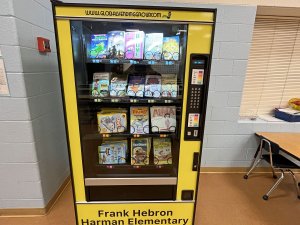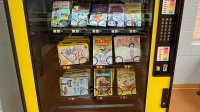The Benefits of Bringing a Book Vending Machine to Your School
A library media specialist shares logistical tips for using a book vending machine to build a strong reading community at your school.
Your content has been saved!
Go to My Saved Content.On the first day of school this year, our students at Frank Hebron-Harman Elementary had an extra reason to be excited: We had a brand-new vending machine in the cafeteria. But instead of dispensing snacks or drinks, our vending machine produces books, which we give to students for free on their birthdays each year.
I first heard about book vending machines at a library conference, where a university professor had experimented with putting the book vending machines in places such as free clinics and laundromats. I thought it was a fantastic way to truly spark our students’ love of reading. Over the past year, we’ve learned a lot of lessons about the logistics of supporting a book vending machine in our school. These tips and tricks have helped our vending machine program be a big success.
Bringing a Book Vending Machine to Your School
Find a supplier for the machine and the books: There are a variety of suppliers that sell vending machines. The vendor we used also provides tutorials for setup, operation, and any error codes you may encounter. Our school also chose to purchase a personalized wrap around the machine to display our school’s name and logo. A local bookstore hosts a fundraiser to donate books for the machine.
Build a strong support team: Books get jammed. Error codes happen. The machine needs to be periodically refilled. Students need to be supervised when accessing books. Our vending machine is managed through the school’s library media center, but your school’s literacy team, parent volunteers, parent teacher association, or other support organizations would be a good fit, too. A team of at least two people, preferably more, should be comfortable with the use of the machine.

Level your books: Our vending machine came with four rows for books. Our school designated the bottom row as pre-K and kindergarten, the next row as first and second grades, the next row as third and fourth grades, and the top row as fifth grade.
Decide when students get new books: Despite the name vending machine, our books aren’t for sale for equity reasons. We didn’t want financial barriers to prevent students from accessing books. We considered awarding books from the book vending machine based on positive behavior. However, students who need free books the most may struggle to earn positive behavior rewards. We decided to offer books on students’ birthdays instead, and on half birthdays for those born during summer months. Our students select their book in the morning on their birthday, when their name is also read over the announcements.
Our students are so excited about receiving their book that they come to us asking for special considerations. For instance, students who move before their birthday sometimes ask to select a book on their last day. These requests let us know the vending machine is increasing student love of literacy and truly becoming part of the fabric of our school community.
Specify what books students can choose: At our school, students may choose any book from their grade level and below. Although some people in our community believe that students should have free choice when it comes to books, we wanted to make sure that students had the ability to read the book they selected.
Be mindful of how students may choose books: Kids are most excited to choose books that they are familiar with. Some students will choose a book that is new to them, but many will choose a familiar book that brings them joy. Mo Willems’s Pigeon books and Elephant and Piggie books are huge hits. Older students enjoy receiving their own copies of Dog Man and Diary of a Wimpy Kid, even though they’ve read them many times before. Older students will occasionally choose a Dr. Seuss book for nostalgic reasons or because that’s what they are most comfortable reading.
Remember that book sizes can be tricky: Some books will be too big, too small, too thick, or too thin to fit in the vending machine slots. We couldn’t find a work-around for books that were too big or too thick, but we did find a solution for the small and thin books. We cut cardboard fabric bolts into smaller pieces and rubber-banded them to the backs of the thinner or smaller books. With this support, they dispense without getting stuck or falling on their own.
A book vending machine has been wonderful for our campus, students and teachers alike. By thinking through a few logistical considerations, your school too can enjoy the benefits.
